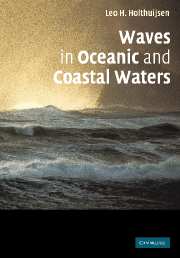Book contents
- Frontmatter
- Contents
- Preface
- Acknowledgements
- 1 Introduction
- 2 Observation techniques
- 3 Description of ocean waves
- 4 Statistics
- 5 Linear wave theory (oceanic waters)
- 6 Waves in oceanic waters
- 7 Linear wave theory (coastal waters)
- 8 Waves in coastal waters
- 9 The SWAN wave model
- Appendix A Random variables
- Appendix B Linear wave theory
- Appendix C Spectral analysis
- Appendix D Tides and currents
- Appendix E Shallow-water equations
- References
- Index
6 - Waves in oceanic waters
Published online by Cambridge University Press: 03 February 2010
- Frontmatter
- Contents
- Preface
- Acknowledgements
- 1 Introduction
- 2 Observation techniques
- 3 Description of ocean waves
- 4 Statistics
- 5 Linear wave theory (oceanic waters)
- 6 Waves in oceanic waters
- 7 Linear wave theory (coastal waters)
- 8 Waves in coastal waters
- 9 The SWAN wave model
- Appendix A Random variables
- Appendix B Linear wave theory
- Appendix C Spectral analysis
- Appendix D Tides and currents
- Appendix E Shallow-water equations
- References
- Index
Summary
Key concepts
In this book, oceanic waters are deep waters (such that the waves are unaffected by the seabed) with straight or gently curving coastlines, without currents or obstacles such as islands, headlands and breakwaters.
Under certain idealised conditions (constant wind blowing perpendicularly off a long and straight coastline over deep water), the significant wave height is determined by the wind, the distance to the upwind coastline (fetch) and the time since the wind started to blow (duration). So are the significant wave period and the energy density spectrum.
Under these idealised conditions, the one-dimensional frequency spectrum has a universal shape: the JONSWAP spectrum for young seastates or the Pierson-Moskowitz spectrumfor fully developedsea states. The (one-sided) directional widthof the corresponding two-dimensional spectrumis typically 30°.
To model waves under more realistic, arbitrary oceanic water conditions, the concepts of fetch and duration cannot be used. Instead, the spectral energy balance of the waves is used. It represents the time evolution of the wave spectrum, based on the propagation, generation, wave-wave interactions and dissipation of all individual wave components at the ocean surface.
Conceptually, a Lagrangianapproach (based on wave rays) or an Eulerianapproach (based on a grid that is projected onto the ocean) can be used to formulate this energy balance. Owing to the interaction amongst the various wave components, the Eulerian approach is better suited for computations than the Lagrangian approach.
Waves are generated by air-pressurefluctuations at the sea surface (not by wind friction), which are almost entirely due to wave-induced variations in the airflow(wind) just above the waves.
[…]
Information
- Type
- Chapter
- Information
- Waves in Oceanic and Coastal Waters , pp. 145 - 196Publisher: Cambridge University PressPrint publication year: 2007
Accessibility standard: Unknown
Why this information is here
This section outlines the accessibility features of this content - including support for screen readers, full keyboard navigation and high-contrast display options. This may not be relevant for you.Accessibility Information
- 2
- Cited by
